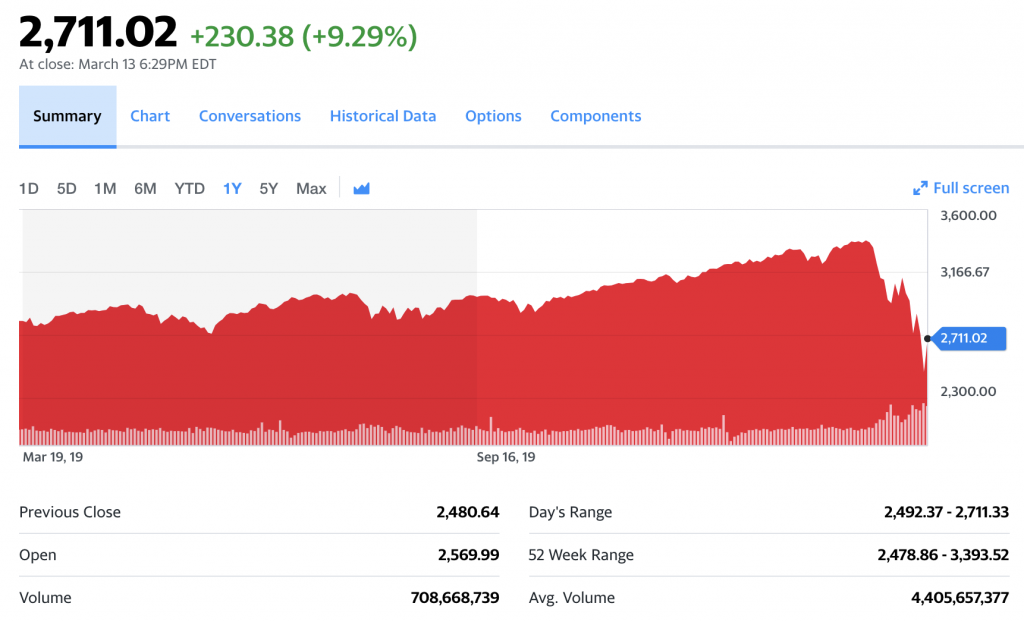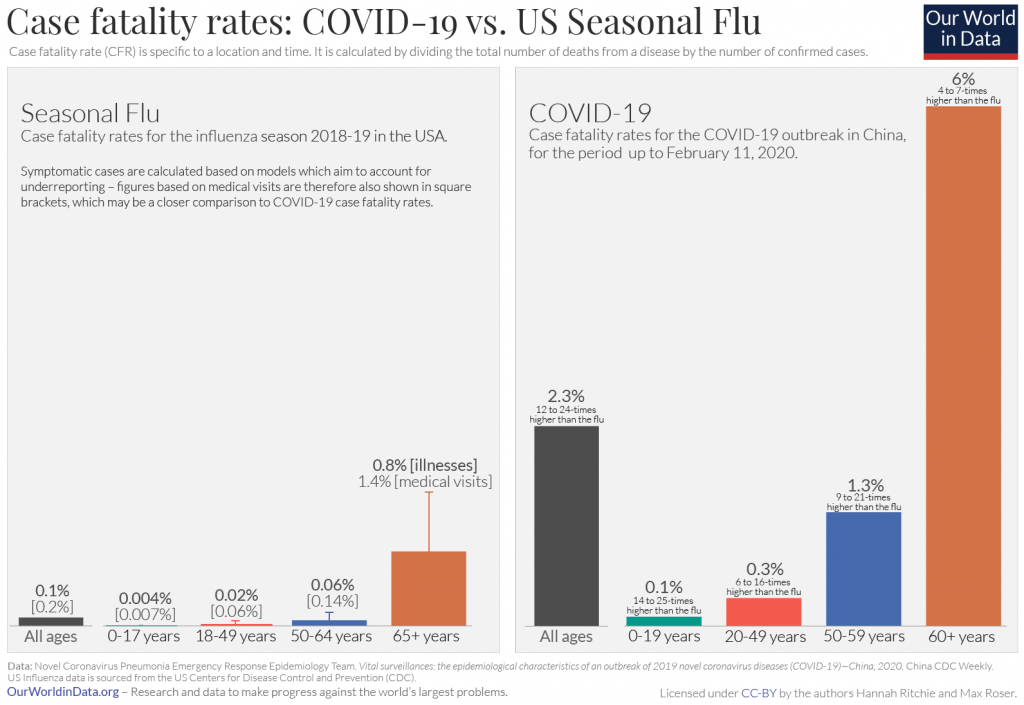Back before I moved heavily into Twitter, DQYDJ used to host a regular series called The Weekender.
Instead of fully fleshed-out thoughts like Cameron and I (try to) offer with the rest of the posts, Weekenders let us shoot from the hip with quicker reactions and round-ups of events and links.
Obviously – besides the frequent trolling there – my Twitter feed has usurped this role. However, I don't have the mind frame to put together a full SARS-CoV-2, COVID-19, and markets post. But this virus – this is a big one, folks. I need more than a tweet to collect my thoughts.
The following are my contemporaneous thoughts as of March 15, 2020.
The Markets
As I write this, the S&P 500 closed Friday at 2,711.02. It is down 20.11% from its recent high of 3,393.52 on February 19, 2020. We're only 17 market days beyond that peak – but at this point, we all know the world has changed.

And we've already entered into a bear market. It took only 20 calendar days to go from the wild, daily record-breaking highs to the bear market – easily the fastest bear market in history.
It's terrible, but my quick reaction as of today is it can get worse. Discount my opinion as you will – our allocation is arguably over-conservative (I'll get you a new one soon) – but the valuation isn't there. Not after a 20% drop.
If you define a recession as any contraction from the peak (adjust for seasonality if you wish), it's time to face it: we're in a recession now.
Sure, many official designations require a timeframe of something like 2 quarters. But economic activity has contracted – I mentioned some of how in the last post – and this won't go away with virus looming.
I'd say you're okay wading in now for 10+ year timeframes, but watch the (admittedly imperfect!) CAPE ratio for a decent entry point for shorter timeframes. Teens would be a decent entry point.
Again, the measure isn't perfect, but if we're staring down a virus lead recession, we can't sustain our current valuations.
No way.
The Economy
As of tonight, I'm still hopeful this is a V-shaped recession.
For a baseline, I think Goldman Sach's call tonight is a decent anchor. They say Q1 falls to +.7%, and Q2 falls to a whopping -5% annualized(!). Optimistically, they predict we have a V-recovery to +3% annualized in Q3.
If we're fortunate, it'll bounce off the viral floor – and watch China's recovery for a hint. If we don't, we'll have to adjust – and I don't know what that means yet. We do already know leisure, hospitality, and travel are absolutely devastated in the near term. Presumably, we'll see some temporary support or bail-out for them in the coming weeks, along with stimulus for workers. On the worker side, I'm anchoring for (eventually) something with a T, as in trillion - yes, $3,000+ in benefits on average for every American if this is a 1Q thing.
The first bill that's coming – not yet passed, as of 3/15 – is H.R. 6201. 6201 guarantees free COVID-19 testing, bolsters state unemployment funds, guarantees food aid, and extends sick leave benefits to many workers. It doesn't currently extend it to companies with 500 or more employees – but keep an eye on it.
H.R. 6201 isn't the last stimulus bill coming. There will almost certainly be other bills – maybe we'll see UBI light or a payroll tax holiday. Follow Claudia Sahm; Claudia's the economist with some of the sharpest ideas on stimulus right now.
The Virus
Unfortunately, we also have to talk about the virus, SARS-CoV-2. That virus leads to the devastating disease, COVID-19.
Mythbusting
I hope at this point everyone has gotten the "it's just the flu!" normalcy bias out of their system. This isn't the seasonal flu, and at this point, the most comparable flu in anyone alive's lifetime is the devastating Spanish Flu of 1918.
As of this Sunday night, so many things are shutting down. The dominoes really started with the NBA (and to mark the watershed, that's when most people started paying attention), but by Sunday night, more than half of the school districts in the country (including mine 😅) have shut down for two or more weeks... pending more news. Don't be shocked at this call – it's going to be longer.
The last myth there is to bust is "this isn't dangerous for young people".
Yes, it's more dangerous for older folks – but current numbers suggest for people under 50, COVID-19 is 10-25x more hazardous than "regular" flu. That means COVID-19 is as dangerous for a 20-49-year-old as the flu is for people in their 60s:

Take this seriously. And oh yeah, you can spread it – including to your older loved ones.
Notes on Spread and Mortality
I'm not an epidemiologist, as you know. But you don't need an infectious disease background to put numbers in Excel.
There are two very important numbers with infectious diseases:
- CFR – case fatality rate, or the percentage of people who will die from contracting a disease
- R0 – r-"naught," the number of people one person is predicted to spread disease onto
Here's the funny thing – both numbers are affected (often favorably) by time and human behavior. Read that again – those are not constants; human reactions, time, bandwidth, luck, and science can all improve – or hurt – both numbers.
R0
We discussed R0 a bit in the last post. More recent data shows that the current estimated R0 is around 2.2. (Flu is ~ 1.5).
Luckily, human behavior can lower this. We talk about social distancing, quarantines, hand-washing, wearing a mask, staying inside – anything you can do to avoid contact with other who may be sick (and with others when you're sick) helps lower this number:

If we can get the number down below 1, we can – in theory – drive infections to zero. But even if we don't, these measures slow the spread and make it possible for the medical system to catch up to increased demand. Hence the concept, "flatten the curve".
The Washington Post has an excellent Data Viz on how measures can reduce the spread of the virus.
Case Fatality Rate (CFR)
The case fatality rate is another measure we can move.
There is a default CFR for any infectious disease, which states, "of the people that catch this, X% will die." It's a very rough number – for diseases that also cause mild illness (like COVID-19), we can overshoot, undershoot, and screw up the rate in all sorts of ways. Consider: cases with mild illness means we'll never test people who had it and got over it!
As of today, the CDC is guiding to around a .8-1% CFR for COVID-19 (bad seasonal flu is around .1%). The natural experiment on the Diamond Princess cruise ship – with near-universal testing – showed a .63% mortality rate, for example. (South Korea, with its extensive testing, shows a similar CFR.)
That's the good news – this might "only" be 6x worse than seasonal flu.
There is bad news too; COVID-19 tends to cause serious illness, which is recoverable in some instances. In China, early numbers suggested as many as 15% of people need hospitalization... and a further 5% need substantial medical intervention, including ventilators or more.
You're looking here at the difference between lower CFRs below 1%, and the higher numbers reported by some countries or areas. If you can't treat patients all at once, people will die that otherwise wouldn't.
As of Sunday, March 15th, this is happening in Italy already. Sadly, some regions need to triage patients and can't extend treatment to every patient presenting with COVID-19. It's terrible, but it's the reality of a shortage of ventilators.
This is the reason why we need to lower R0/flatten the curve: we need to avoid overwhelming the bandwidth of the system. Even if everyone* in America eventually gets sick, if it takes a long enough time, everyone can get the resources we need.
*100% will never happen due to herd immunity, but follow my thoughts here.
Other Thoughts
Both numbers also will drift lower due to other factors. R0 will lower simply due to awareness; the people at bars now will (hopefully) socially distance more when they become acutely aware of the dangers here. It's already happening at restaurants.
It would be best if you had optimism on the CFR side, too. Currently (again, as of 3/15/2020) Gilead Pharmaceutical's Remdesivir and the old malaria stalwart chloroquine seem to work against COVID-19. Additionally, plasma from COVID-19 survivors and work with COVID-19 antibodies is also promising.
On the over-the-counter side, Vitamin D is almost undoubtedly useful (let Dr. John Campbell explain), and zinc is probably helpful as the mechanism of chloroquine.
Most of my other theories are an engineer's naive stretch/hopecasting – efficacy in influenza, related-to-chloroquine, and so-on. Maybe they'll pan out, but actual MDs are pointing at Zinc and Vitamin D as useful defenses. I'm paying attention.
Worried – and Optimistic
COVID-19's spread across the planet is stressful and surreal. And it's deserved – we know now this is not the flu, and the implications of this virus are only just now being felt.
This, too, shall pass, but the world has changed. Do what you need to fix your cash flow, but expect that many areas of the economy are resilient to this shock when the worst has passed.
But most importantly – there will be plenty of time to reflect. For now, take care of yourself and your loved ones. We're all in this together; let's do our part to flatten the curve.
